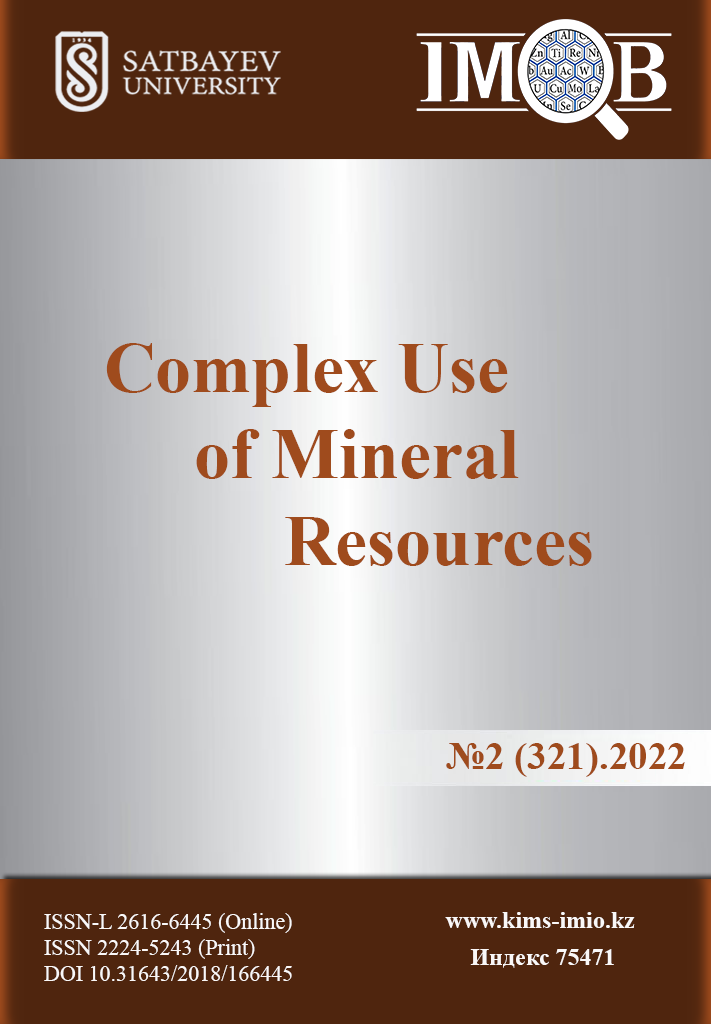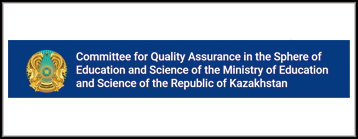Granular materials based on expanded sands and their production waste
DOI:
https://doi.org/10.31643/2022/6445.13Keywords:
granular material, expanded perlite, expanded clay sand, composite binders, porous structure.Abstract
The article presents the results of studies of granular materials obtained by non-firing technology. For the formation of granules, composite cement and magnesia binders containing waste products of expanded perlite and expanded clay are proposed. Mechanical activation of composite binders intensifies the processes of hydration and structure formation, contributes to increasing the strength of materials. The combination of a binder with a filler in the form of waste from the production of porous aggregates ensures a decrease in the density of the binder, the formation of a finely dispersed porous structure of the composite material, the formation of stable hydrates. The porous structure of the granules is provided by the use of porous sand to form the core of the granules. Studies of the structure of granules by electron microscopy revealed that the reliable adhesion of particles of porous sand with a composite binder stone provides high strength of porous granular materials. Cement granules based on expanded perlite sand are characterized by a density of 300 – 400 kg/m3 and a compressive strength of 1.8 – 2.6 MPa. Magnesia granules based on expanded clay sand have a density of 450 – 500 kg/m3 and compressive strength of 3.5 – 5.7 MPa. The work is aimed at creating effective building materials using resource-saving technology, at the rational use of production waste.
Downloads
References
Kumar KN, Vijayan DS, Divahar R, Abirami R, NivethaC. An experimental investigation on light-weight concrete blocks using vermiculite. Materials Today: Proceedings2020;22(3):987–991. https://doi.org/10.1016/j.matpr.2019.11.237
Min H-W, Kim S,Kim HS. Investigation on thermal and mechanical characteristics of concrete mixed with shape stabilized phase change material for mix design. Construction and Building Materials2017;149:749–762. https://doi.org/10.1016/j.conbuildmat.2017.05.176
Xu B, Li Z. Paraffin/diatomite composite phase change material incorporated cement-based composite for thermal energy storage. Applied Energy 2013;105:229–237. https://doi.org/10.1016/j.apenergy.2013.01.005
Sangulova IB, Selyaev VP, Kuldeev EI, Nurlybaev RE, Orynbekov YS. Assessment of the influence of the structural characteristics of granular systems of microsilicon on the properties of thermal insulation materials. Kompleksnoe Ispol’zovanie Mineral’nogo Syr’a = Complex Use of Mineral Resources2022;320(1):5–14. https://doi.org/10.31643/2022/6445.01
Devecioglu AG, Bicer Y.The effects of tragacanth addition on the thermal and mechanical properties of light weight concretes mixed with expanded clay.Periodica Polytechnica Civil Engineering2016;60(1):45–50. https://doi.org/10.3311/PPci.7984
Borges A, Flores-Colen I, Brito J. Physical and mechanical performance of cement-based renders with different contents of fly ash, expanded cork granules and expanded clay. Construction and Building Materials2018;191:535–543. https://doi.org/10.1016/j.conbuildmat.2018.10.043
Miryuk О, Fediuk R, Amran M. Foam Glass Crystalline Granular Material from a Polymineral Raw Mix. Crystals2021;11: 1447. https://doi.org/10.3390/cryst11121447
Burbano-Garcia C, Hurtado A, Silva YF, Delvasto S, Araya-LetelierG. Utilization of waste engine oil for expanded clay aggregate production and assessment of its influence on lightweight concrete properties. Construction and Building Materials2021;273:121677. https://doi.org/10.1016/j.conbuildmat.2020.121677
Zhou J, Ji L, Gong C, Lu L, Cheng X. Ceramsitevegetated concrete with water and fertilizer conservation and light weight: Effect of w/c and fertilizer on basic physical performances of concrete and physiological characteristics of festuca arundinacea. Construction and Building Materials2020;236(10):117785. https://doi.org/10.1016/j.conbuildmat.2019.117785
Gao H, Xia S, Chen F, Stuedlein AW, Li X, Wang Z, Shen Z, Chen X. Dynamic shear modulus and damping of cemented and uncemented lightweight expanded clay aggregate (LECA) at low strains. Soil Dynamics and Earthquake Engineering2021;142:106555. https://doi.org/10.1016/j.soildyn.2020.106555
Sravya YL, Manoj T, Seshagiri RMV. Effect of temperature curing on lightweight expanded clay aggregate concrete. Materials Today: Proceedings 2021;38(5):3386–3391. https://doi.org/10.1016/j.matpr.2020.10.568
Roces E, Muñiz-Menéndez M, González-Galindo J, Estaire J. Lightweight expanded clay aggregate properties based on laboratory testing. Construction and Building Materials2021;313:125486. https://doi.org/10.1016/j.conbuildmat.2021.125486
BicerA. The effect of fly ash and pine tree resin on thermo-mechanical properties of concretes with expanded clay aggregates. Case Studies in Construction Materials2021;15:e00624. https://doi.org/10.1016/j.cscm.2021.e00624
Angelin AF, Lintz RCC, Osório WR, Gachet LA. Evaluation of efficiency factor of a self-compacting lightweight concrete with rubber and expanded clay contents. Construction and Building Materials2020;257:119573. https://doi.org/10.1016/j.conbuildmat.2020.119573
Xu M, Liu L, Deng Y, Zhou A, Gu S, Ding J. Influence of sand incorporation on unconfined compression strength of cement-based stabilized soft clay. Soils and Foundations2021;61(4):1132–1141. https://doi.org/10.1016/j.sandf.2021.06.008
Sun D, Wang L, Li C. Preparation and thermal properties of paraffin/expanded perlite composite as form-stable phase change material. Materials Letters2013;108:247–249. https://doi.org/10.1016/j.matlet.2013.06.105
Chung O, Jeong Su-G, Kim S. Preparation of energy efficient paraffinic PCMs/expanded vermiculite and perlite composites for energy saving in buildings.Solar Energy Materials and Solar Cells2015;137:107–112. https://doi.org/10.1016/j.solmat.2014.11.001
Zhang X, Wen R, Tang C, Wu B, Huang Z, Min X, Huang Y, Liu Y, Fang M, Wu X. Thermal conductivity enhancement of polyethylene glycol/expanded perlite with carbon layer for heat storage application. Energy and Buildings2016;130:113–121. https://doi.org/10.1016/j.enbuild.2016.08.049
Zhang N, Yuan Y, Li T, Cao X. Lauric–palmitic–stearic acid/expanded perlite composite as form-stable phase change material: Preparation and thermal properties. Energy and Buildings2014;82:505–511. https://doi.org/10.1016/j.enbuild.2014.07.049
KocianovaM, DrochytkaR.Possibilities of lightweight high strength concrete production from sintered fly ash aggregate. Procedia Engineering2017;195:9–16. https://doi.org/10.1016/j.proeng.2017.04.517
Miryuk ОА. Granular magnesia compositions. Kompleksnoe Ispol’zovanie Mineral’nogo Syr’a = Complex Use of Mineral Resources 2021;316(1):32–39. https://doi.org/10.31643/2021/6445.04
Kumar S, Sonat C, Yang E-H, Unluer C. Performance of reactive magnesia cement formulations containing fly ash and ground granulated blast-furnace slag. Construction and Building Materials2020;232:117275. https://doi.org/10.1016/j.conbuildmat.2019.117275
Miryuk О. Porous magnesia compositions with various fillers. Lecture Notes in Civil Engineering2021;147:344 –350. https://doi.org/10.1007/978-3-030-68984-1_50
Downloads
Published
How to Cite
Issue
Section
License
Copyright (c) 2022 Miryuk, O., & Zagorodnyuk , L.

This work is licensed under a Creative Commons Attribution-NonCommercial-NoDerivatives 3.0 Unported License.


























